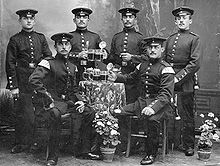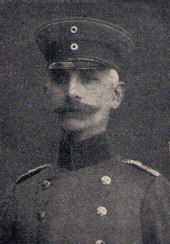2nd Upper Rhine Infantry Regiment No. 99
|
2nd Upper Rhine Infantry Regiment No. 99 |
|
|---|---|
| active | 1881 to January 1919 |
| Country | Kingdom of Prussia |
| Armed forces | Prussian Army |
| Branch of service | infantry |
| Former locations | Zabern and Pfalzburg |

The second Oberrheinische Infantry Regiment. 99 was an infantry joined the Prussian army .
history
Laying down were companies of the infantry regiments no. 6 , 7 , 19 , 37 , 46 , 50 , 58 , 59 , 73 , 74 , 78 and 91 used.
As a garrison , the association initially moved to Posen and Schrimm . In 1889 the regiment was moved to the realm of Alsace-Lorraine and was initially stationed in Strasbourg and Pfalzburg . In 1890, two battalions were finally given their final location in Zabern in Lower Alsace, where they were housed in the Rohan Castle , which had been used as barracks since 1871 and where the regimental commander and his staff resided, while the rest of the unit was in the neighboring Palatinate Castle, which was already in Lorraine remained.
The regiment was part of the 60th Infantry Brigade and therefore subordinated to the 30th Division .
Zabern affair
The regiment hit the headlines of the German and international press in the so-called " Zabern Affair " at the end of 1913, which was triggered by the misconduct of the young lieutenant Günter von Forstner. Because of offensive remarks about the Alsatians, which had reached the press after indiscretions, he drew the resentment of the population, which was expressed in demonstrations and hostility. The military reacted to this with disproportionate violence and eventually suspended civil authority in the garrison town. The troops were then temporarily withdrawn from Zabern at the behest of Kaiser Wilhelm II and transferred to the military training areas in Oberhofen near Hagenau (I. Bat.) And Bitsch (II. Bat.). The regiment commander at that time, Colonel Ernst von Reuter, had to answer to a military court together with another officer of the regiment (Lieutenant Schadt). To the horror of the liberal public, both were acquitted of allegations of unlawfully appropriating civil power. The officers involved were transferred to other locations, however, before the two battalions returned to their Zabern garrison on April 5, 1914.
First World War
With the outbreak of World War I , the regiment mobilized on August 2, 1914. Initially deployed in border protection against France, the association took part in the battle of Lorraine and then before Nancy - Epinal . During the First Battle of Flanders , the regiment suffered heavy losses near Ypres . Therefore, two companies each were merged into one and on November 20, 1914, the 1st and 2nd Battalions were combined into one. After the replacement was supplied , the regiment was replenished on December 8, 1914. It took part in the trench warfare in this section of the front until the beginning of 1916 and then fought throughout the year in the Battle of Verdun . During this time the regiment was expanded to include a 2nd machine gun company in February and a 3rd machine gun company in September . On September 1, 1918, the association received a mine thrower company.
Whereabouts
After the end of the war , the regiment was demobilized in Schmalkalden from January 1919 . As early as December 19, 1918, the volunteer battalion " Petri " was formed from parts , which was then transferred to the Hasse Freikorps and deployed to guard the border in Upper Silesia near Rybnik and Pless. Later, from February 1920, the Freikorps was transferred to the Reichswehr Infantry Regiment 108 as 1st Battalion.
The tradition was taken over in the Reichswehr by decree of the Chief of the Army Command, General of the Infantry Hans von Seeckt of August 24, 1921, by the 16th Company of the 3rd (Prussian) Infantry Regiment stationed in Marienburg .
Commanders
| Rank | Surname | date |
|---|---|---|
| Lieutenant colonel | Julius Bergmann | March 22, 1881 to May 17, 1881 (in charge of the tour) |
| Lieutenant Colonel / Colonel | Julius Bergmann | May 18, 1881 to June 3, 1885 |
| Colonel | Paul Steffen | June 4 to July 13, 1885 |
| Lieutenant colonel | Eduard von Münnich | July 14, 1885 to July 5, 1886 (in charge of the tour) |
| Colonel | Eduard von Münnich | July 6, 1886 to May 21, 1889 |
| Colonel | Wilhelm Winckel | May 22, 1889 to April 15, 1892 |
| Colonel | Joseph Dobbelstein | April 16, 1892 to May 19, 1893 |
| Colonel | Hugo Laurin | May 20, 1893 to March 21, 1897 |
| Colonel | Adolph Tecklenburg | March 22, 1897 to August 1, 1900 |
| Colonel | Oskar von dem Hagen | August 18, 1900 to April 17, 1903 |
| Colonel | Richard Junk | April 24, 1903 to September 10, 1907 |
| Colonel | Rudolf Heuer | September 11, 1907 to April 20, 1911 |
| Colonel | Adolf Barth | April 21, 1911 to November 18, 1912 |
| Colonel | Ernst von Reuter | November 19, 1912 to February 2, 1914 |
| Lieutenant colonel | Friedrich Gündell | February 3 to March 21, 1914 (in charge of the tour) |
| Colonel | Friedrich Gündell | March 22 to September 25, 1914 |
| Colonel | Hans Nollau | September 26 to November 11, 1914 |
| Lieutenant colonel | Walter Schmidt | November 11, 1914 to April 4, 1915 |
| Lieutenant colonel | Friedrich Bethcke | April 5, 1915 to April 25, 1917 |
| Colonel | Hans Böckler | April 26 to October 30, 1917 |
| Lieutenant colonel | Wilhelm Haupt | October 31, 1917 to January 17, 1919 |
| Colonel | Werner Madlung | January 18, 1919 until dissolution |
literature
- Hans Friedrich Hübner: Officer master list of the 2nd Upper Rhine Infantry Regiment No. 99. ES Mittler & Sohn , Berlin 1906.
- Jürgen Kraus : Handbook of the associations and troops of the German army 1914-1918. Part VI: Infantry. Volume 1: Infantry Regiments. Verlag Militaria, Vienna 2007, ISBN 978-3-902526-14-4 , p. 173.
- Shipman, Hugh, 2015: Palingbeek 1915 - The Battle for the Ridge Between The Bluff and Hill 60 . - Heartnut Publishing, ISBN 978-0993256301 .
Individual evidence
- ^ Günter Wegmann (Ed.), Günter Wegner: Formation history and staffing of the German armed forces 1815-1990. Part 1: Occupation of the German armies 1815–1939. Volume 2: The occupation of the active infantry regiments as well as Jäger and MG battalions, military district commandos and training managers from the foundation or list until 1939. Biblio Verlag, Osnabrück 1992, ISBN 3-7648-1782-8 , p. 252.


